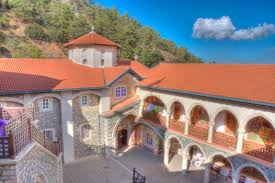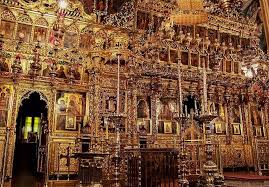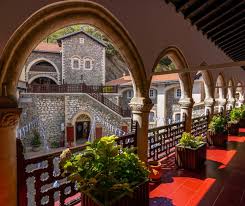Coming to Cyprus - Kykkos Monastery
Kykkos Monastery (Panagia tou Kykkou, Cyprus)
The Kykkos Monastery, officially known as the Holy Monastery of the Virgin of Kykkos (Panagia tou Kykkou), is widely regarded as the most important and magnificent monastery in Cyprus. Standing proudly at an altitude of around 1,300 metres in the Troodos Mountains, it commands breathtaking views across pine-covered slopes, valleys, and distant peaks. The monastery lies about 60 km from Paphos, 75 km from Limassol, and roughly 3 km from Throni Hill, where a monument and tomb to Archbishop Makarios III, the first President of Cyprus, now stand.
The drive to Kykkos is one of the most scenic on the island. From Paphos or Limassol, winding mountain roads climb steadily into the heart of the Troodos range, passing through vineyards, cedar forests, and traditional stone-built villages such as Omodos, Pedoulas, and Kakopetria. The air becomes cooler and clearer as you ascend, and every bend reveals a new panorama. Many visitors stop along the way at small tavernas or viewpoints before reaching the monastery gates, making the journey as memorable as the destination itself.
The origins of Kykkos trace back to the late 11th century, during the reign of Byzantine Emperor Alexios I Komnenos. According to legend, a hermit named Isaiah discovered an icon of the Virgin Mary in a remote cave on this mountainside. The Emperor’s representative in Cyprus, tormented by illness, sought the hermit’s prayers and was miraculously cured. In gratitude, the Emperor ordered that a grand monastery be built to house the icon, which is believed to have been painted by Saint Luke the Evangelist. The sacred image — covered today with silver and gold and never fully revealed to the public — remains the monastery’s most treasured relic and is said to bring blessings and protection to all who visit.
Throughout its long history, the Monastery of Kykkos has endured fires, invasions, and earthquakes, yet it has always been rebuilt, each time more splendid than before. The current complex dates mostly from the 18th and 19th centuries and showcases the grandeur of Cypriot-Byzantine architecture. Behind its fortified stone walls lies a series of interconnected courtyards surrounded by arcaded walkways, balconies, and fresco-covered walls depicting scenes from the Bible and the lives of saints. The main church, richly adorned with gold leaf and icons, exudes both opulence and serenity.
Every surface of Kykkos seems to radiate colour and artistry — from the dazzling mosaics that glint in the sunlight to the intricate woodcarvings inside the chapel. The atmosphere is at once peaceful and reverent, a blend of living faith and cultural heritage. Incense drifts through the air, monks move quietly between buildings, and the sound of bells echoes across the mountain valleys.
Visitors should not miss the Kykkos Monastery Museum, which contains one of the most important collections of religious art in Cyprus. Among its treasures are ancient icons, illuminated manuscripts, gold chalices, vestments, and relics dating back hundreds of years. The museum also tells the story of the monastery’s pivotal role in Cypriot history — not just as a place of worship, but as a centre of education, charity, and national identity, particularly during Ottoman and British rule.
Just a few kilometres further up the road is the Tomb of Archbishop Makarios III, who began his spiritual life here as a novice monk. Set on Throni Hill, the tomb is approached by a short stone path lined with mosaics and guarded by ceremonial soldiers. The viewing terrace above offers magnificent panoramic views over the Troodos Mountains and, on a clear day, as far as the sea.
A visit to Kykkos typically lasts two to three hours, though most travellers make a full-day trip of it, combining the monastery with stops at nearby wineries, mountain trails, and charming villages. There is a souvenir shop selling honey, wine, and local products made by the monks, and several small tavernas nearby where you can enjoy a hearty Cypriot lunch.
The monastery is open daily (usually from 10:00 to 16:00, longer in summer). Entry is free, though donations are welcomed. Modest dress is required — shoulders and knees should be covered — and scarves or wraps are available at the entrance.
In many ways, Kykkos Monastery encapsulates the spiritual and cultural heart of Cyprus. Its remote mountain setting, rich history, and artistic splendour combine to create an experience that is both humbling and uplifting. Whether you are drawn by faith, architecture, history, or simply the beauty of the Troodos Mountains, a visit to Kykkos is a journey into the soul of the island — a serene and timeless sanctuary that continues to inspire all who make the pilgrimage.


